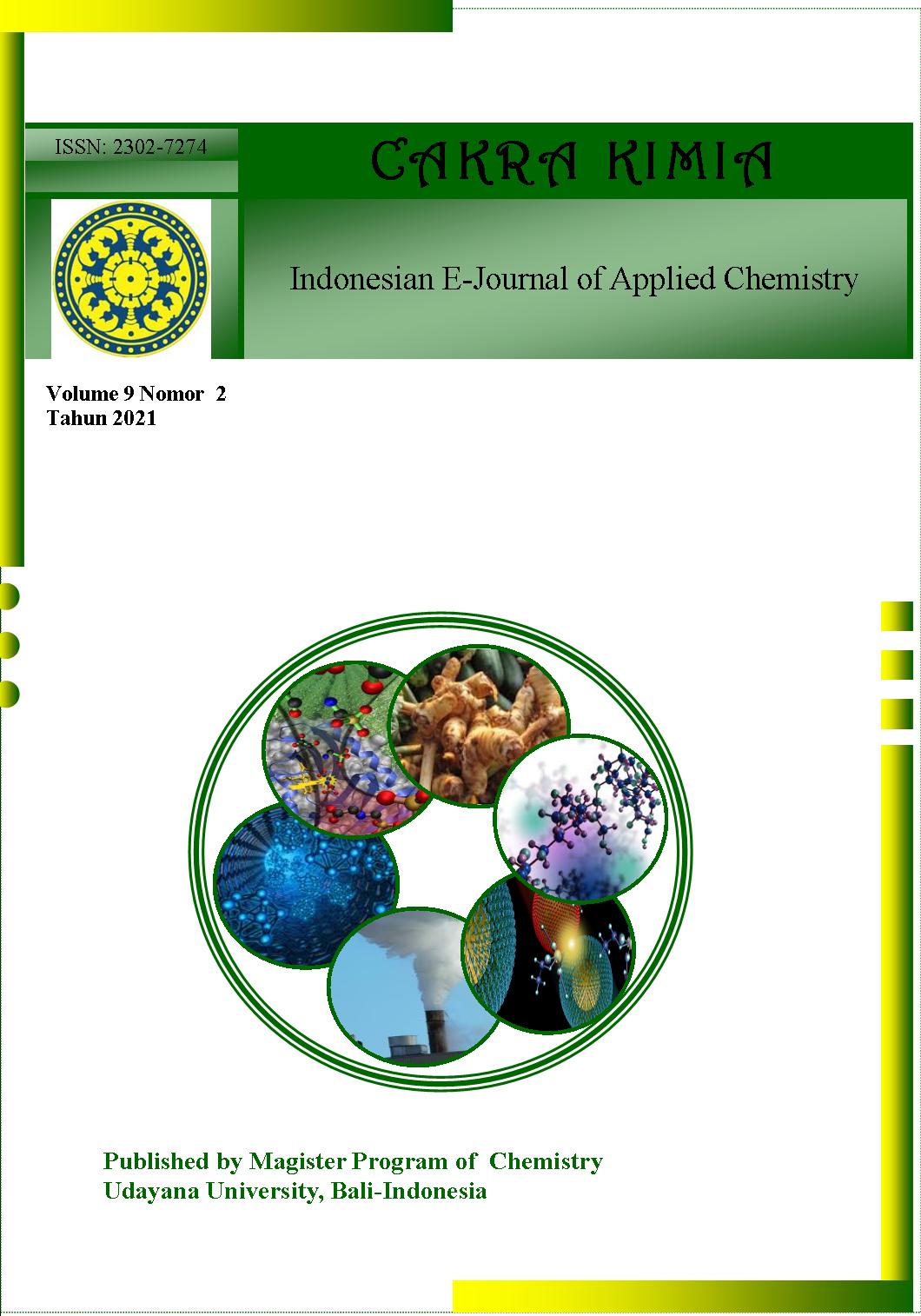KANDUNGAN LOGAM Pb DAN Cu DALAM TANAMAN BAYAM DAN BIOAVAILABILITASNYA DALAM TANAH PERTANIAN DENGAN PEMBERIAN PUPUK NPK
Abstract
ABSTRAK: Pencemaran logam berat pada tanah pertanian akibat penggunaan pupuk anorganik seperti pupuk NPK dapat berdampak pada kandungan logam berat dalam tanaman hasil pertanian. Penelitian ini bertujuan untuk mengetahui kandungan logam Pb dan Cu dalam tanaman bayam dan tingkat bioavailabilitas logam tersebut dalam tanah pertanian dengan pemberian pupuk NPK. Metode yang diterapkan pada penelitian ini adalah digesti basah untuk menetapkan logam berat total dan ekstraksi bertahap untuk spesiasi dan menentukan bioavailabilitas logam berat tersebut. Kuantifikasi Pb dan Cu dilakukan dengan menggunakan alat Atomic Absorption Spectrofotometer (AAS) dengan metode kurva kalibrasi dan adisi standar. Pada penelitian ini ditemukan bahwa kandungan logam Pb dan Cu pada tanaman bayam mengalami peningkatan berturut-turut dari 59,7617 dan 14,0713 mg/kg untuk tanaman tanpa pupuk NPK menjadi 80,2736 dan 21,5550 mg/kg pada tanaman dengan pemberian pupuk NPK. Penggunaan pupuk NPK pada tanah pertanian juga dapat meningkatkan logam yang bioavailable sebesar 0,83% untuk Pb dan 2,70% untuk Cu. Dengan demikian, pemberian pupuk NPK pada tanah pertanian dapat menyebabkan peningkatan bioavailabilitas Pb dan Cu dalam tanah dan kandungannya dalam tanaman bayam.
ABSTRACT: Heavy metal contamination in agricultural soil due to the use of inorganic fertilizers such as NPK fertilizer could have an impact on heavy metal content in agricultural products. This study aimed to determine the metal content of Pb and Cu in spinach and the level of bioavailability of these metals in agricultural soils treated with NPK fertilizer. The methods applied in this study were wet digestion and sequential extraction for determining the total metals of Pb and Cu, as well as the bioavailability of these metals. The measurement and quantification of the metals were performed by the use of an Atomic Absorption Spectrophotometer (AAS) with applying calibration curve and standard addition techniques. In this study, it was found that the metal contents of Pb and Cu in spinach plants increased from 59,7617 and 14,0713 mg/kg, respectively for plants without NPK fertilizer to 80,2736 and 21,5550 mg/kg in plants with NPK fertilizer application. The use of NPK fertilizer on agricultural soils could also increase the bioavailable metal by 0,83% for Pb and 2,70% for Cu. Therefore, the application of NPK fertilizer to the agricultural soils could increase the bioavailability of Pb and Cu in the soil and their content in the spinach plants.
Downloads
References
[2] Taylor, M.D. and Percival, H.J. Cadmium in Soil Solution from A Transect of Soil Away from A Fertilizer Bin. Environmental Pollution. 2001,113(1), 35-40.
[3] Parmiko, I.P.M., Siaka, I.M., dan Suarya, P. 2014. Kandungan Logam Cu dan Zn dalam Tanah dan Pupuk serta Bioavailabilitasnya dalam Tanah Pertanian di Daerah Bedugul. Jurnal Kimia. 2014, 8(1), 91-96.
[4] Hayati, E. Pengaruh Pupuk Organik dan Anorganik Terhadap Kandungan Logam Berat dalam Tanah dan Jaringan Tanaman Selada. J. Floratek. 2010, 5, 113-123.
[5] Angima, S. Toxic Heavy Metals in Farm Soil. Oregon State University. 2010, 5(3), 1-3.
[6] Florence, T.M., Morrison G.M., and Stauber J.L. Determination of Trace Element Speciation of the Role of Speciation in Aquatic Toxicity, Elsevier Science publisher B.V., Amsterda. CSIRO Center for Advanced Analytical Chemistry. 1992.
[7] Davidson, C.M., Duncan, A.L., D. Littlejohn, A.M., Ure, L.M. Garden. 1998. A Critical Evaluation of the Three–Stage BCR Sequential Extraction Procedure to Assess the Potential Mobility and Toxicity of Heavy Metals in Industially-Contaminated Land. Analytica Chimica Acta. 1998, 393, 45-55.
[8] Siaka, I.M. Spesiasi dan Bioavailabilitas Logam Berat dalam Tanah dan Akumulasinya dalam Sayuran Sebagai Dasar Penentuan Tingkat Aman Konsumsi. Disertasi. Universitas Udayana. 2016.
[9] Pinta, E. Analisis Kandungan Logam Timbal pada Sayur Kangkung dan Bayam di Jalan Kartama Pekanbaru Secara Spektrofotometri Serapan Atom. JOM FMIPA. 2015, 2(1), 75-82.
[10] Ittana, F. Metal in Leafy Vegetables Grown in Addis Ababaand Toxicological Implication. Ethiopian Journal of Health Development. 2002, 6, 295-302.
[11] Okoronkwo, NE, Igwe, JC., and Onwuchekwa, EC. Risk and Health Implications of Polluted Soils for Crops Production. African Journal of Biothecnology. 2005, 4(1), 1521-1524.
[12] Gasparatos, D., Haidaouti, C., Andrinopoulus, and Areta, O. Chemical Speciation and Bioavailability of Cu, Zn, and Pb in Soil from the National Garden og Athens, Greece. Proceedings: International Conference on Environmental Science and Technology. Rhodes Island, 2005.
[13] Widowati, W., Sastiono, A., dan Yusuf, R. Efek Toksik Logam. Andi. 2008.
[14] Reichman, S.M. The Response of Plants to Metal Toxicity: A Review Focusing on Copper, Manganese and Zinc. The Austalian Minerals & Energi Environment Foundation, 2002.



 Petunjuk Penulisan
Petunjuk Penulisan
